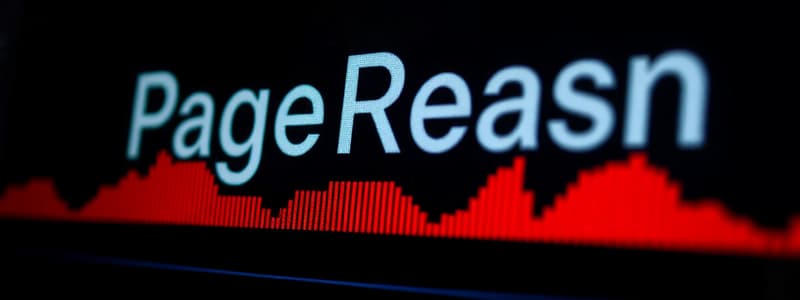Podcast
Questions and Answers
What is the purpose of following robots.txt when crawling a website?
What is the purpose of following robots.txt when crawling a website?
- To eliminate duplicates in the index.
- To prioritize crawling important pages first.
- To ensure the crawler fetches all available URLs.
- To prevent overwhelming the server with requests. (correct)
Which of the following qualities is NOT associated with a good web crawler?
Which of the following qualities is NOT associated with a good web crawler?
- Fresh
- Robust
- Infrequent (correct)
- Scalable
What challenge does parallelization help to overcome in the crawling process?
What challenge does parallelization help to overcome in the crawling process?
- Extracting URLs from crawled pages.
- Fetching and parsing page content.
- Managing the URL pool effectively.
- Handling numerous pages efficiently. (correct)
How is the URL Frontier managed in a web crawler?
How is the URL Frontier managed in a web crawler?
What is a primary reason for maintaining content freshness in web crawling?
What is a primary reason for maintaining content freshness in web crawling?
What is the primary reason for using PageRank over HITS in search engines?
What is the primary reason for using PageRank over HITS in search engines?
Which of the following statements about hubs and authorities is true?
Which of the following statements about hubs and authorities is true?
Which distribution typifies the number of incoming links expected for pages?
Which distribution typifies the number of incoming links expected for pages?
What happens to hub value in the PageRank system?
What happens to hub value in the PageRank system?
What defines a small-world network as mentioned in the content?
What defines a small-world network as mentioned in the content?
Why is normalization necessary in the HITS algorithm?
Why is normalization necessary in the HITS algorithm?
In the context of link structures, what is a base set?
In the context of link structures, what is a base set?
What is the relationship between hub scores and authority scores?
What is the relationship between hub scores and authority scores?
Flashcards
Web Crawler
Web Crawler
A tool that gathers web page content by systematically visiting and analyzing URLs.
Crawler Politeness
Crawler Politeness
A crawler's respect for website rules and limitations to avoid overloading or impacting the site's performance.
URL Frontier
URL Frontier
A system managing crawlers' tasks by prioritizing and scheduling the URLs to be visited and ensuring that no URL is visited more than once.
Crawler Freshness
Crawler Freshness
Signup and view all the flashcards
Robots.txt
Robots.txt
Signup and view all the flashcards
PageRank
PageRank
Signup and view all the flashcards
HITS (Hubs and Authorities)
HITS (Hubs and Authorities)
Signup and view all the flashcards
Authority Score
Authority Score
Signup and view all the flashcards
Hub Value
Hub Value
Signup and view all the flashcards
Root Set
Root Set
Signup and view all the flashcards
Base Set
Base Set
Signup and view all the flashcards
Small-world network
Small-world network
Signup and view all the flashcards
Power Law Distribution
Power Law Distribution
Signup and view all the flashcards
Study Notes
Page Rank and HITS Algorithms
- PageRank and HITS are algorithms used to determine the importance of web pages.
- HITS (Hubs and Authorities) assigns two values to each page: hub value and authority value.
- Hub value represents the number of links pointing from a page to other pages.
- Authority value represents the number of links pointing to a page from other pages.
- A high authority score indicates a page with quality information that other pages link to.
- A high hub value indicates a page that links to many important pages.
PageRank Algorithm
- PageRank is a widely used algorithm for determining web page importance.
- It measures the importance of a page based on the importance of the pages linking to it.
- The algorithm considers all pages as a graph with links representing edges.
- Each page in the graph receives an initial PageRank score.
- Each page's PageRank score is calculated iteratively.
- The PageRank score of a page is a function of the PageRank scores of all the pages linking to it.
- The calculation accounts for the number of outgoing links from each page.
- The algorithm converges after a certain number of iterations, providing a normalized PageRank value for each page.
Base Set and Authority/Hub Score Calculations
- The base set is the set of pages relevant to a given query.
- The base set comprises pages directly related to a query and those linked to the directly related ones.
- Authority score (a(i)) of a page is calculated as the sum of hub scores (h(j)) of all pages that link to it.
- Hub score (h(i)) of a page is calculated as the sum of authority scores (a(j)) of all pages that it links to.
Small-World Networks
- Small-world networks exhibit a high clustering coefficient and a short average path length between any two nodes.
- The clustering coefficient measures the density of connections among neighbors of a node.
- The average path length measures the average number of steps needed to reach any node from any other node.
- Such networks show characteristics of both regular networks and random networks.
- Real-world examples of small-world networks include social networks and biological networks.
Web Crawler
- Web crawlers are automated programs that traverse the web by following links between pages.
- Crawlers collect information, store it, and index it for search engines and other users to find relevant content.
- One of the steps in crawling is URL initialization and the identification of initial set of URLs.
- Crawlers follow links within pages to follow a set of path and collect data from web pages.
- The crawling process must be well-organized and manageable
- Politeness, freshness and robustness are important factors for web crawlers.
URL Frontier
- URL Frontier is a system for managing and prioritizing URLs to be crawled.
- Queues are used to organize URLs to ensure appropriate crawling.
- Queues also help to maintain a priority between various pages to be crawled.
- It also ensures that the politeness and freshness of the crawled pages are maintained.
Studying That Suits You
Use AI to generate personalized quizzes and flashcards to suit your learning preferences.




